Welcome to Boston! Monday will be my 24rd running of the Boston Marathon and 18th consecutive. I’ll be out there this year trying to come in under 3 and that will make it 31 consecutive years of of running a marathon under 3 hours. 33 consecutive years is the world record so my kids are keeping me honest for a few more years. The predicted 30 mph headwinds and cold rain will make it a bear but the fun will be in the challenge. According to Weather Underground there is 0% chance it is not going to rain 🙂 .
Here is a nice chart my friend Nick Pang made from the chart below on the 30 year streak.
Below is a list of my best time for each year over the last 30 years. The average time is a little 2:35. I won’t be near that this year but I feel healthy and unless the weather or the gods of marathoning work against me I feel good about finishing the chances of finishing under 3 hours, although the margin is getting tighter. Over these 30 years and close to 100 marathons my slowest finish is 3:00:00 at Air Force Marathon in 2016 where I ran a large amount of the race barefoot.
| 1988 | 2:34:02 | MCM (Marine Corps) |
| 1989 | 2:32:41 | MCM |
| 1990 | 2:31:52 | MCM |
| 1991 | 2:30:26 | Boston |
| 1992 | 2:36:35 | MCM |
| 1993 | 2:31:10 | Boston |
| 1994 | 2:31:01 | MCM |
| 1995 | 2:24:30 | Rome |
| 1996 | 2:27:20 | MCM |
| 1997 | 2:27:20 | Boston |
| 1998 | 2:34:02 | Air Force |
| 1999 | 2:24:45 | Chicago |
| 2000 | 2:28:55 | MCM |
| 2001 | 2:29:12 | Boston |
| 2002 | 2:29:56 | Boston |
| 2003 | 2:33:37 | MCM |
| 2004 | 2:39:41 | MCM |
| 2005 | 2:34:47 | MCM |
| 2006 | 2:31:42 | Boston |
| 2007 | 2:37:48 | MCM |
| 2008 | 2:34:48 | MCM |
| 2009 | 2:37:04 | Boston |
| 2010 | 2:34:21 | Boston |
| 2011 | 2:37:00 | Boston |
| 2012 | 2:42:07 | Air Force |
| 2013 | 2:42:54 | Boston |
| 2014 | 2:48:59 | Boston |
| 2015 | 2:55:40 | MCM |
| 2016 | 2:55:26 | MCM |
| 2017 | 2:56:03 | Boston |
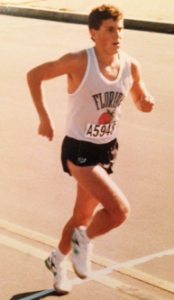
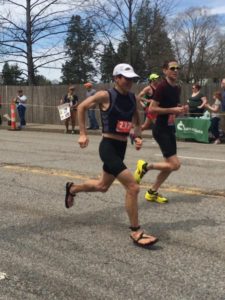
What is the sustainable path? In today’s culture there is a trend and emphasis on high-intensity training as the path to success. I agree that for immediate performance this is true, but the jury is out if we are talking about long-term health and balance if one has a busy life. Be careful of who you look to for advice, especially if they do not actually run or are former runners. Also be cautious if the advice is linked to short term fitness and not to long term health
The late Dr. George Sheehan often wrote “we are all an experiment of one”. This is true, but I think one must understand the principles of overall health and how to treat your body to keep the experiment going. Since my foot surgeries in 2000, I have not done any training which would be considered “hard” or “anaerobic” by modern extreme fitness zealots. Most proponents of “pain is gain” cannot produce this type of sustainable performance data in themselves or any of their clients or athletes. I have not missed a Boston or Marine Corps since 2000 (and have not had running related injury since then either) and despite some years of extreme weather at these races the times are all consistent with the gentle physiologic age related decline.
So what is the “secret sauce” of long-term healthy running?
- Run for joy
- Recover. Slow Jogging is your friend. Honestly if you eat and train well you do not do damage so there is no real “recovery” in the modern lexicon of protien shakes , ice baths, rollers, massages, compression, etc….
- Learn to use fat as fuel. Read about how this works here
- Do not run too hard. Running is recovery and you should always feel better when you get back then when you went out the door
- Keep “fast and agile” with short sprints and drills. Just did a short post here.
- Keep mobile, esp in the ankles and hips.
- Keep your foundation strong–this is your foot. Wear flat shoes shaped like your foot to stand, walk, run, and play. Go barefoot as often as you can.
- Learn the skill of running and keep trying to master this. A tool like TrueForm motorless treadmill helps. Watch our videos.
- Do simple strength training with Kettle Bells and Burpees
- Be your own body sensor and coach
- Don’t sit
- Eat real food and as you age limit the carbs.
- Do not put pain into your body
- And pass it forward…we all continue to learn by teaching and sharing with others.
I follow the wisdom of Dr. Phil Maffetone who ran a nice profile too on all the stuff we are doing here to spark a healthy community and empower each individual to take ownership of their health.
http://philmaffetone.com/maf-profile-mission-heal/
Phil and I are launching health care education courses under HealthFitU with our partnership with TrueForm Running
Look for our course this September 29-30 to be posted soon.
…………………………………………….
So Now on to the Boston Strategy
For starters, remember when you are on the line Monday morning you are already over 95% done. That is the training you have done to prepare. So the race is the final fun lap done in the comradarie with others (and the occasional band on the course). Here are a few visualizations to help you set your plan. Running your best 10k is mostly about fitness. Running your best marathon is a mix of art, science, guts, and faith in what you can do. It is never too late to learn new things .
As you enter race weekend here are a few strategies to help you set your plan. The best analogy I can think of is this: if you have trained your body properly with the right mix of aerobic level training and some up tempo stuff in recent weeks, you have built your efficient hybrid engine ready to race the marathon. Many of you have driven in a Prius and watched the subtle shifts between gas and electric on the dashboard. You do not perceive these shifts. Your engines (muscles) run on a mixture of gas (sugars) and electric (fats). Utilizing gas or electric power depends on the effort. This is why slow aerobic training is critical for marathon success, you build a massive electric (fat burning) engine.

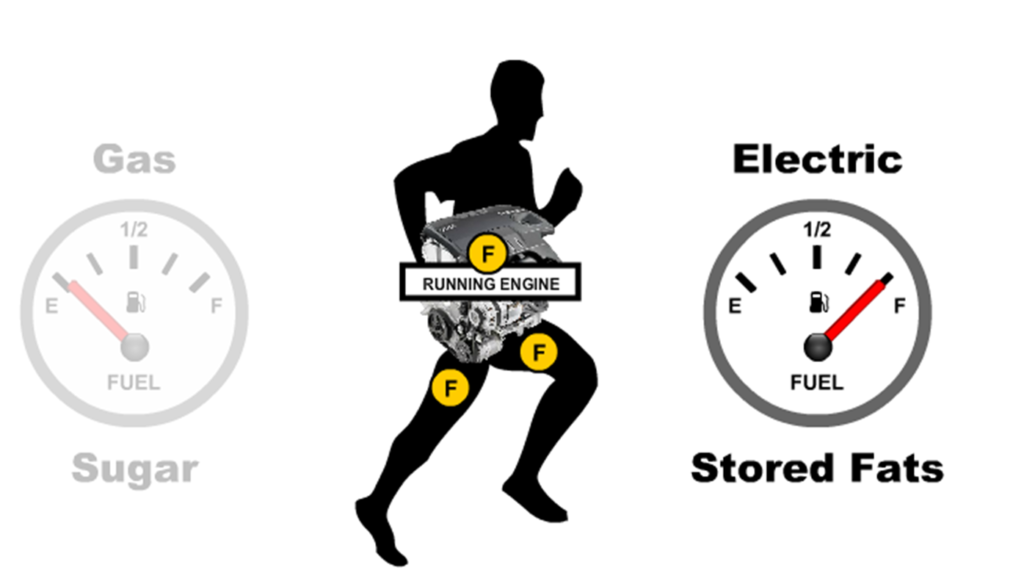
Learn How To Be a Better Butter Burner Here
Imagine you are starting the race with one gallon in the gas tank- assuming you have eaten a nice meal the night before with a light breakfast top off. If you race in all gas mode, your engines will run about 1.5 hours at a strong pace….then you are out of gas. If your effort is mostly electric you can run for hours, but not as swiftly.
With the correct effort you (1) will use the proper fuel mix and you will be efficient for duration of your event and (2) you can even do some topping off along the way. Too hard early you will sabotage the day by not only depleting the gas but also shunting all blood flow to working muscles, thereby not allowing the aid station top offs to assist.
Running utilizes about 1kcal/Kg/Km. So for a lean marathoner of 80 kg you need about 3360 kcals (80kg x 42 km) to make it. The gas is the glucose utilizing pathway. Even fully carbo loaded, your stored liver glycogen (300-500kcal), muscle glycogen (1000-1500kcal), and blood glucose (less than 20 kcal) don’t add up. Glucose is easy to access for ready energy but adds up to less than 2000kcal. The fat utilizing pathway is the electric. In marathons you must be in hybrid mode to make it. Hybrid is where your energy (ATP) is coming from both fuel sources. Conserving the gas and using electric early in the race is critical.
Many runners are in great “10k shape” (an all gas event), train in all gas mode, start their marathon in the all gas mode….and crash. Glycogen sparing strategy need not apply in races of less than an hour as long as you had a good pre-event meal to fill the tank. In marathons and ultras, top end anaerobic fitness matters little and can only be applied very near the finish. Glucose gives 36 ATP per molecule with a limited supply, fat 200-400 ATP per molecule and an unlimited supply. You must tap into the fat burning tank. Now you know how a bird can migrate 7000 miles without an aid station. It’s all about adaptation in training and the pace.
Another key to teaching your body how to burn fat and to maximize aerobic development is to not eat before or during your long runs. If you are reading this for the first time before this years’s race then apply to your next marathon with several months to prep. Your body adapts to exposures and if sugar is constantly accessible you will not learn how to burn fat. You also want to convert your fast twitch fibers to make them as “red” (oxidative) as possible. Easy and moderate effort long runs of 2 hours in a fasted state will drain the slow twitch fibers (“red” fibers) of glycogen and force more capillarization of the fast twitch (mix “white”/”red”) fibers, making them more “red”.
You are doing covert “speed work” by running slow with this method, making the powerful fast twitch fibers aerobic. Distance runners in events from 800 meters to marathons through generations have trained this way. This is part of the Lydiard method and validated by the life work of Dr. Stephen Siler. Only recently have we been convinced by industry that we need lots of sugar before and during long runs. Race day is different as you are going for performance, not creating adaptations. More on this later.
So how do you know you are running in your best hybrid mode?
This is difficult because the body sense at this level (Aerobic Threshold-AeT) is not as profound as Lactate Threshold (or Anaerobic Threshold- AT). A slight increase from your AeT pace will switch you from hybrid to all gas without you realizing it. The effects are felt miles later. Charging and surging early will tap your gas quickly. If you want to speed up early….DON’T. Relax and maintain comfortable effort, not always a specific speed. You should feel easy in the early stages, it is a marathon.
You must rehearse in training. I focus on relaxation and belly breathing. If able to breathe through my nose then I’m hybrid. If I can talk comfortably I’m hybrid. If breathing faster, I’m using mostly glucose as fuel. (note: glucose metabolism produces more CO2 and that is part of why you breathe faster at hard efforts- you need to blow off the CO2). Belly breathe- allow lower belly to blow up like a beach ball on inhalation as your powerful diaphragm contracts. You will fill the lower lung areas where oxygen exchange occurs. Notice the breathing efforts of those around you. Many are rapid breathing. They will suffer somewhere past half way. Practice nasal breathing, it forces belly breathing and prevents you from running in too high a gear. Nasal breathing also allows CO2 to rise naturally to assist in offloading the oxygen to the tissues. Blowing off CO2 in excess binds the oxygen to the hemoglobin, inhibiting offload to the tissues. I used a product called a Nasal Turbine at the 2016 and 2107 Boston Marathons and it helps the nasal breathing.
Rehearse complete relaxation from the top down- eyes, jaw, shoulders. Allow your legs to relax and extend behind you. Your core is controlled and your legs are the springs. Find you own cue for this. My cue is to soften the hips and ankles for full hip extension and ankle plantar flexion. If you use a Heart Rate Monitor in training strongly consider one during the event. For a great read pick up an out of print copy of “Relax and Win” by Bud Winter who taught fighter pilots as well as world class sprinters.
“Watch his lower lip,” Winter said. Winter is a sun-scorched, intense man who talks very rapidly, as if his ideas outpaced his words. “That’s what we work on. The lower lip and the hands. If his lower lip is relaxed and flopping when he runs, his upper body is loose. If his hands are relaxed, his arm muscles are relaxed. You got to run relaxed to get maximum speed. If you have antagonistic muscles working against each other, you’re working against yourself.”
In a marathon, the last 3-4 miles you will be mostly gas to maintain the same speed as fatigue sets in and heart rate rises. The breathing rate increases and that is OK. Stay relaxed and use the cues that you have rehearsed to keep your form.
Now for a bit on form. Land softly, especially on the early downhills. Focus on good form. Land soft and springy with good “impact moderating behavior” harnessing elastic recoil. Gently landing on and rolling from the heel can work as can midfoot/forefoot. Mix it up. Do not overstride with fully extended leg. Focus on posture and hip extension. Your trunk will lean forward slightly. Think “face forward” and look ahead. Run over the ground not into the ground. I’m never sore after marathons now.
With good form it is “No pain…thank you”. Find a nice rhythm. Races are filled with excitement and distractions. For you there are no distractions, just peace in the moment. You get it now- the art of a marathon is to relax and be in the moment. And yes smile and enjoy along the route.
Now for a little on the most important organ for running- your brain. Your brain is the captain of the ship and will always try to protect you. Even at “all in” we are only really using 50-60% of our capacity. The brain likes homeostasis and running 26 miles is counter to this. Assuming you are medically healthy you can play some tricks to outwit your brain which is constantly telling you to slow down or stop. Work around the bad patches with your mind and find a better mental place. You are not “done”. Shift your stride, take something at the aid station, run mile to mile, sing a song, relax and slow the breathing. You want to be “parasympathetic” (rest and digest) . This is happy land. If your brain tells you the body is in peril, “sympathetic” (fight or flight) stress kicks in. This is good for running from a wild animal (a sprint), but not for persistence hunting ( a marathon) .
Your shoes matter too. Make strong consideration to not running in minimalist racers unless you have trained substantially in them and adapted your structure to less foot support and a natural style gait. I advocate gradually adapting all of your training into more minimal and level shoes. When you learn to relax your lower legs and load the springy tendons in your feet and lower legs- the firm, light, and flexible shoes with no heel elevation put you in perfect position to allow natural elastic recoil of plantar fascia, Achilles and lower leg tendons, and hip flexors. The last year 2 years I was part of a study with Dr Irene Davis and wore my Vibram 5 Fingers (2016) and Luna Sandals (2017). Since it has been bitter cold and I have not done much sandal running I’m going with the feather light Altra Vanish this year weighing in at 4 ounces.
New research and runner’s experience is now making the case for running with a focus on form and questions modern running footwear. The evolving world of modern sports medicine is going back to the future too and rediscovering what evolution has taught us. For more on footwear and form spend some time on “RunRx” on http://naturalrunningcenter.com/ . The button is along the upper menu – drop down links with Chapters. Lots of drills with run form stuff, endurance, strength, glutes, etc. Much of it in video. The “Fun Drills” tab has the dynamics (lunge matrix, sumo, world’s greatest stretch) The recent ACSM guidelines are also a great read on footwear.
Have a course specific plan for your race. My best learning experiences were when the men and women started together and I had the privilege of running alongside and witnessing the patient approach and incredibly efficient running of the top ladies.
In the 1997 Fatuma Roba, the Marathon Gold Medalist in Atlanta and 3 time Boston winner, scooted over the ground with an incredibly efficient motion. She hydroplaned along, hips extending, arms relaxed, and face always relaxed. She stayed out of trouble by tucking behind the lead pack of more aggressive ladies. I followed behind the train and we hit half way in about 1:13. Fatuma then opened her stride up in the second half moving away from all of us to run a 2:23. An amazing second half effort. I was pleased with a 2:27 that day and credit Fatuma as any thoughts to go faster sooner were mitigated by her patience.
A few years later in 2001 I witnessed multiple world champion and Boston winner Catherine “the Great” Ndereba employ the same strategy. Her light springy stride and complete relaxation of effort were a contrast to other ladies in the pack who’s body language and breathing displayed they were putting out more energy than Katherine. As a group we hit the half in 1:14. Catherine kept relaxed down the long downhill at mile 16 then tightened the screws with a huge acceleration over the Newton hills, running a 50 minute last 10 miles for a 2:24. Catherine helped my day. By cueing off her pacing and relaxation I ran an even race and finished in 2:29.
The other runner who taught me to have fun out there was the legendary 3 time Boston winner Uta Pippig of Germany. In 2002 I ran with her until she dropped me at Cleveland Circle (mile 22). The crowds loved Uta and the noise escalated as she approached. She smiled the whole way. Maybe this was her cue to relax, feed off the crowd’s energy, and have fun in the moment. In marathoning you must be present in the moment. Do no not think about how far you have to go, what you may feel like later, wondering if you are going to slow down, fearing the wall is coming. Uta ran a strong fourth place that day in 2:28 and I finished a few strides back in 2:29. She is an example of how our brains govern our effort. When we are positive it flows.
All of these ladies made sure to get their fluid and nutrition at all stops. The few extra seconds used here paid dividends down the road. They also ran over the road not into the road, especially on the downhills. One could hardly hear them land as they did not employ overstriding technique. Their posture was tall and their arms always relaxed. But most vital was their overall efficient energy conservation and utilization strategy.
Save energy for the later stages of the race, this is where things can get tough. Remember, if you feel really good in the early stages and feel like you want to speed up….DON’T. It is a marathon and you should feel good in the early miles. Don’t take the bait. Charge when you can “smell the barn”, this occurs when you see the Citgo sign (comes into view at Mile 23). Now a few extra ways to get from start to finish quicker on the same gallon.
- Do not sabotage your event by having a large carbohydrate heavy breakfast the morning of the race. This will increase your insulin levels and lock out the ability to burn fat. Fill your energy stores by not running and eating adequate amounts of fats, protein, and some healthy carbohydrates the 3 days prior. Do not overload, you can only store a specific amount. A light breakfast of mix carb/fat/protein is a good thing as well as your morning coffee if you are a coffee drinker. Personally I am insulin resistant with age so I do not carbo load and prefer the slow release super starch UCAN the morning of events and on courses where I can leave a bottle or two. I have adapted to using primarily fat as fuel and want to do use fat during the race. The UCAN Hydrate electrolytes are my secret weapon on the course as the small straw packet can be tucked into your shorts. Add this to the water to get proper hydration and the right balance of sodium and potassium.
- If you can add a little gas along the way this helps both glucose and fat burning. Adding just a little is best. If running too fast or if is temperature high you shunt blood to working muscles and to the skin to cool and the blood diverts from the gut, so nothing digests. Plus you are burning quickly through the glucose/gas. If you are in hybrid in the early going you can continually add some fuel. So the key is not only the correct fuel, but the right pace. Just a little sugar every 30 minutes is easy to digest and can help keep you fat burning till the final miles. Drink mostly water with some electrolytes instead of the sugar loaded drinks which are often less predictable on the run and can spike your insulin and blood sugar.
- The early downhills are fun but if run too hard can drain your gas quickly and damage your quads. Go smooth and easy down them. Allow gravity assist you down. Do not overstride with hard heel hit on the down hills.
- Maintain effort on uphills. Your pace will slow. You can easily use all your gas here if your effort increases. Shorten your stride, relax, and use your arms. Relax and recover on the downs. Save something for this section of the race!
- If you are having a “bad patch” – try to refocus on relaxing, fuel a bit (sometimes a blood glucose drop triggers the sense of doom), and have faith in your training and race plan. Another nice trick is when you hit mile 21 it is not 5 miles to go, it is 4 and change. Mile 22 is 3 and change to go. Just run to the next mile marker and count them down one by one. Smile and enjoy the crowds.
- If it is windy get behind a group. This can save lots of physical and mental energy.
- Do not over drink water. This can lead to a dangerous condition called hyponatremia. The AMAA homepage has a link on the current guidelines
- It is not going to be hot but for future reference read this article I wrote after the steamy 2012 Boston Marathon which was published in the American Medical Athletic Association Journal
- For the cold and wet I remember 2007 where they almost canceled the race. This year could be a similar day. So an awesome baselayer is the key. My fav is XoSkin. Made in the USA and proud supporter of the US Air Force.
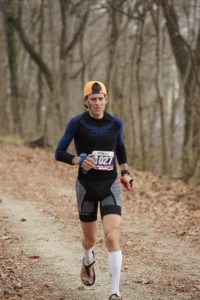
- A final tip from 4 time Olympic Trials qualifier Josh Cox who spoke with me before the Air Force Marathon a few years ago. The night before the race make “the invisible man”. Get everything you are going to wear/use the next day set up to put on in the morning. Scrambling to find your number, socks, favorite hat, gels or other item adds stress. Get the outfit laid out on the floor ready to wear, then get some sleep.
The fun of the marathon is that we are always learning and enjoying the adventure of it. We learn from experience, taking chances, and occasional failures. Train to race efficiently and economically in the marathon, but still there are uncertainties every time you line up. I learn something new every time. So relax, taper up, and seize the day.
I’d like to especially thank all the Armed Forces Members around the world who sacrifice daily in the service of their country and for all the volunteers who make the Boston Marathon a Patriots Day celebration. Run a fearless race and may the wind be at your back . One fearless competitor is Ironman World Record holder Tim Dom making an incredible comeback. Wow.
Good luck to all of you and see you at the start and the finish!
Mark Cucuzzella MD, Professor West Virginia University School of Medicine


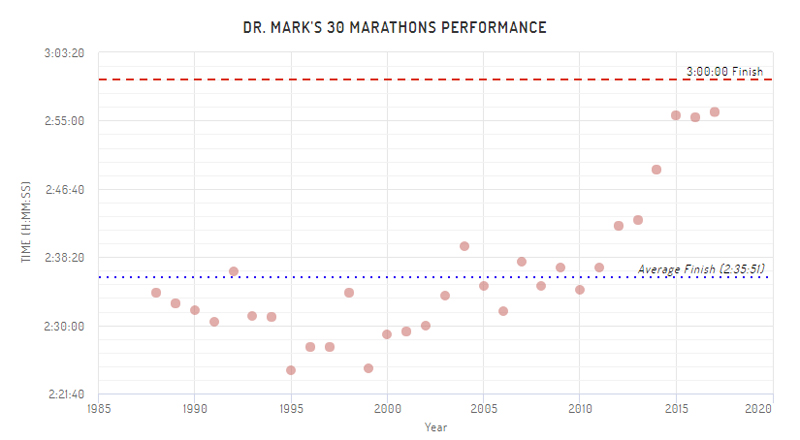
Congratulations on finishing another Boston Marathon, Dr. Mark. i wish I could do at 30 what you are doing right now.
I’ve been following your blog for the past few years along with the work of people like Dr. Maffetone. I’ve been trying to implement some of the things I’ve learned for a little while, but am just finally able to fully commit now. That tip about relaxing the face and hands really helped me with my run today.
I’ve read a little bit of info on breathing from your nose and have come across the work of George Catlin. It still feels rather forced when I try to breathe from my belly though. Any advice on how to work on this, or do I just need some time to get used to it? Thanks!
Mark sounds like you had a decent day all things considered. the breathing does take practice. do not force the nasal breathing if it does not feel right. just stay chill and relax